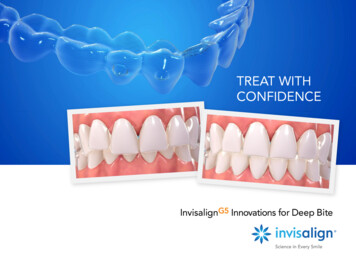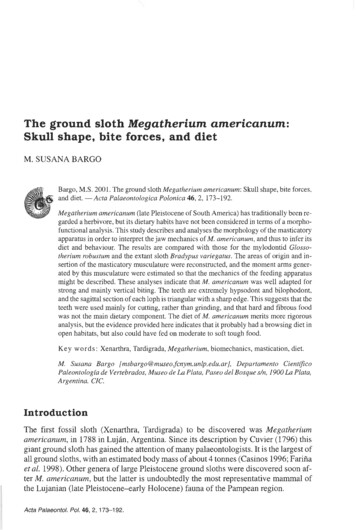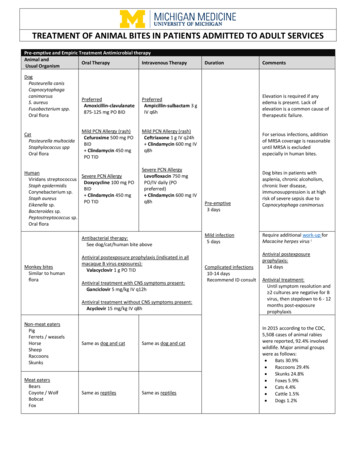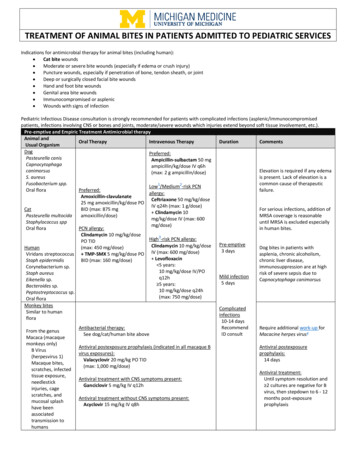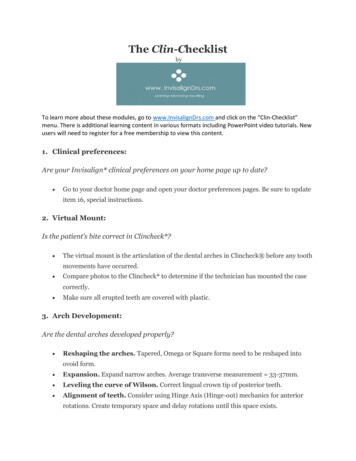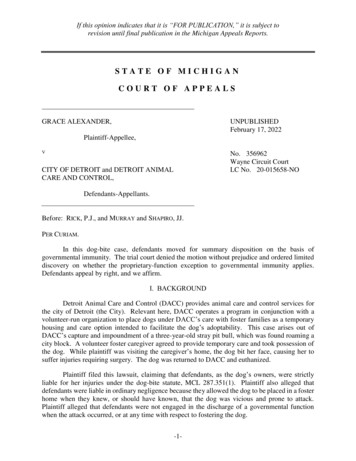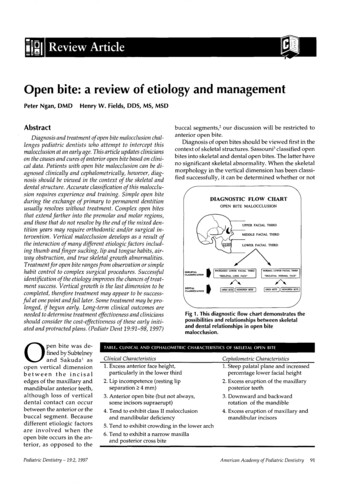
Transcription
Openbite: a review of etiology and managementPeter Ngan, DMDHenry W. Fields, DDS, MS, MSDAbstractDiagnosisandtreatment of openbite malocclusionchallenges pediatric dentists whoattempt to intercept thismalocclusionat an early age. This article updatesclinicianson the causesandcures of anterioropenbite basedon clinical data. Patients with open bite malocclusioncan be diagnosedclinically and cephalometrically, however, diagnosis should be viewedin the context of the skeletal anddental structure. Accurateclassification of this malocclusion requires experience and training. Simple open biteduring the exchange of primary to permanentdentitionusually resolves without treatment. Complexopen bitesthat extend farther into the premolarand molarregions,and those that do not resolve by the end of the mixeddentition years may require orthodontic and orsurgical intervention. Vertical malocclusiondevelops as a result ofthe interaction of manydifferent etiologic factors including thumband finger sucking, lip and tonguehabits, airwayobstruction, and true skeletal growthabnormalities.Treatmentfor openbite ranges from observation or simplehabit control to complexsurgical procedures. Successfulidentification of the etiology improvesthe chancesof treatment success. Vertical growthis the last dimensionto becompleted, therefore treatment mayappearto be successful at one point andfail later. Sometreatment maybe prolonged, if begun early. Long-termclinical outcomesareneededto determinetreatment effectiveness and cliniciansshould considerthe cost-effectiveness of these early initiated and protracted plans. (Pediatr Dent 19:91-98, 1997)OPen bite was defined by Subtehaeyand Sakuda 1 asopen vertical dimensionbetween the incisaledges of the maxillary andmandibular anterior teeth,although loss of verticaldental contact can occurbetweenthe anterior or thebuccal segment. Becausedifferent etiologic factorsare involved when theopen bite occurs in the anterior, as opposed to l segments) our discussion will be restricted toanterior open bite.Diagnosis of open bites should be viewedfirst in thecontext of skeletal structures. Sassouni3 classified openbites into skeletal and dental openbites. Thelatter haveno significant skeletal abnormality. Whenthe skeletalmorphologyin the vertical dimension has been classified successfully, it can be determined whether or notDIAGNOSTIC FLOWCHARTOPEN BITEMALOCCLUSIONUPPER FACIAL MIDDLEFACIAL THIRDLOWERFACIAL THIRDFig 1. hipsin openbitemalocclusion.AND CEPHALOMETRIC CHARACTERISTICS OF SKELETAL OPEN BITEClinicalCharacteristics1. Excessanterior face height,particularly in the lowerthird2. Lip incompetence(resting lipseparation 4 mm)3. Anterior openbite (but not always,someincisors supraerupt)4. Tendto exhibit class II malocclusionand mandibular deficiency5. Tendto exhibit crowdingin the lower arch6. Tendto exhibit a narrow maxillaand posterior cross biteCephalometricCharacteristics1. Steep palatal plane and increasedpercentagelower facial height2. Excesseruption of the maxillaryposterior teeth3. Downwardand backwardrotation of the mandible4. Excesseruption of maxillary andmandibularincisorsAmericanAcademyof PediatricDentistry91
a dental open bite accompaniesthe skeletal relationships. Fig 1 shows that there are multiple variants ofthis problem.Patients can be diagnosed (or classified) clinicallyand/or by cephalometric analysis, as shown in theTable. Proffit characterized patients with skeletal openbite and a large total face height manifestedentirely inthe elongation of the lower third of the face as havinglong face syndrome.4 Clinically and cephalometrically,these patients have a disproportionately long lowerfacial third. Loweet al. determined that although facial proportions are important, vertical facial typescould be separated reliably using simple, linear6extraoral measuresfor males and females. Fields et al.demonstratedthat increased interlabial gap was statistically significant between normal and long face children and adults with a mean difference from normalof 2x and 5x, respectively. Unfortunately, evidencesuggests that general dentists trained to clinically detect vertically disproportionate faces are not reliable atthat task. 7 In an effort to dissect this problemof vertical facial types morescientifically, Loweet al. 8 appliedquantitative assessments (Fourier and cluster analyses)to vertical and anteroposterior profiles of a great rangeof patients. They found distinct characterization anddiscrimination difficult. This samestudy suggested thatspecialists can makereliable clinical discriminationsbetween vertical facial types after training. In summary, clinical vertical classification of patients can beaccomplished, but it must be attempted with care andappropriate training.Investigators disagree on the site of the skeletal disturbances associated with long faces. Someinvestigators 9 noted the maxilla wasat fault, while others6,1 indicated the lower face associated with mandibularmorphology (ramus height or mandibular plane) wasthe location of the disturbance.Excessive dental eruption is a confusing variable. Ina study by Fields et al., no dental vertical variables wereobserved in adults, but long face children had significantly more vertical development, except in the max6illary anterior region.The study of facial morphologysuggests that facialtypes, no matter howthey are defined, are a complexentity. The inter-relationshipsof the regions makecephalometric measures highly correlated because theyoften look at similar morphologyfrom slightly different perspectives. 11 Such correlations should not beviewed as confirming the identification of the sourceof a problem.The inter-relationships are a result of themethodof analysis, not the problem of inquiry. Whenthese correlations are taken into account, it appears thatthe lower face height is at fault in patients with clini6cally disproportionate vertical facial relationships.Oncethe skeletal abnormality is identified, patientscan be classified as dental open bite or nonopenbite.Patients with increased lower face height may or maynot have an anterior dental open bite. 1 In all patients,an open bite exists during the exchangeof primary in92AmericanAcademyof PediatricDentistrycisors to permanent incisors, which is part of normalgrowth and development.In summary, both normal and long face skeletalmorphology are observed in association with normaland open bite dental occlusion. In other words, theopenbite dental occlusion is not indicative of a specificskeletal relationship.Prevalenceandproblemsrelated to openbitesThe prevalence of skeletal long face malocclusion isunknown, but has been estimated to be 0.6% or1,350,000 U.S. citizens. 4 The prevalence of dental openbites in U.S. children is approximately16%in the blackpopulation and 4%in the white population, 12 with theprevalence of simple anterior open bites (involvingmainly the incisors) decreasing until adolescence. 3 Allchildren experience anterior open bites during the transition from the primary to permanent dentitions withlittle disruption in their oral physiology during thisperiod, which can span I to 2 years.Masticatory14 and speechis problems have been attributed to openbites. Theinability to incise is the chiefcomplaint often voiced by open bite patients. Other16patients indicate displeasure with their facial esthetics.Manyopen bites will resolve by gradually closingwithout treatment, and transitional open bites, whichmake up manyof the simple open bites, are of littleconsequence. Complex open bites, those that extendfarther distally and those that do not resolve at the endof the mixed dentition years, can be more problematic.Relationship betweentemporomandibularjointdysfunction(TMD)and openbiteSeveral studies have related the morphologicaspectsof malocclusion to mandibular dysfunction in children. 7-2 Williamson surveyed 304 pre-orthodonticpatients (aged 6-16), and found that 72%of those withpain dysfunction symptoms had either open bite ordeep bite. 17 In a random sample of 402 children,Egermark-Erickssonet a128 found a correlation betweenTMJclicking and dental wear. They also found thatfunctional malocclusion due to occlusal intereferenceswas more important than morphologic malocclusion inthe etiology of mandibulardysfunction28In a later longitudinal study on malocclusionin relation to signs andsymptomsof TMD,the authors found that no singleocclusal factor is of major importance in the development of TMD,but that morphological malocclusionsuch as crossbite and anterior open bite might be apotential risk factor29 In a larger longitudinal studywith 7337 Japanese children, the prevalence of TMDwas found to be 12.2%. In subjects with TMD,72.9%exhibited some form of malocclusion and 5.4% hadopen bite. Because a large number of subjects withTMDalso had malocclusion, the authors recommended2 early treatment to prevent severe TMD.EtiologyAccording to Dawson, 1 the major causes of an anterior open bite are forces that result from thumb orPediatricDentistry- 19:2,1997
finger sucking, pacifier use; lip and tongue habits; airway obstruction; inadequate nasal airway creating theneed for an oral airway; allergies; septumproblems andblockage from turbinates; enlarged tonsils and adenoids; and skeletal growth abnormalities. This reviewwill demonstrate that one factor is unlikely to be thecausative agent and a multifactoral etiology that mostlikely explains open bite problems. Our discussion canonly be used as information on howto treat the condition when, and if, certain diagnostic and etiologic criteria are present.Thumbandfinger suckingor pacifier useIn younger children, the major cause of anterioropen bite (excluding open bites associated with thetransition from the primary to mixed dentitions) arenon-nutritive sucking habits. By adolescence, environmental causes of anterior open bite are less importantthan skeletal factors.Prolonged thumb-suckingtends to create this malocclusion. A surprisingly large percentage (10-15%)children continue to suck a thumb, finger, or other object well into the elementary school years, la Johnsonand Larson2 use the term non-nutritive sucking (NNS)to describe habits that involve digits, pacifiers, andother environmental influences. Twotheories addressthe possible cause of NNS:Freud’s psychoanalyticaltheory and the learning theory. A combined explanation suggests that all developmentally normal childrenpossess an inherent, biologic drive for sucking. Therooting and placing reflexes are merely an expressionof this drive. Furthermore, environmentalfactors contribute to the transfer of this sucking drive to non-nutritive sources, such as the thumbor fingers.A typical thumb-sucker has a malocclusion characterized by an asymmetricanterior open bite due to digitposition and a transverse constriction of the maxillaryarch. Adair, et al. evaluated the effects of orthodontic23and conventional pacifiers on the primary dentition.The results showeda statistical increase in overjet inthe "orthodontic" pacifier group and significantlygreater incidence of open bite in the conventional pacifier group when these groups were compared. Subsequent data demonstrate no significant benefits ofnonconventional pacifiers, but a tendency for opena4bites to close after cessation of the habit,Lip andtonguehabitsDentists and speech therapists often attribute openbite malocclusion to abnormaltongue function. Straubsuggested that tongue thrusting can produce open bitesbut presented no data to substantiate the claim,a5 Jamesand Townsend described different types of tonguea7thrusting based on the resulting deformities, a6 Tulleyclassified tongue thrusting as an endogenoushabit oras an adaptive behavior based largely on facial morphology and swallowing activity.According to Proffit and Mason, tongue thrust ismore likely to be an adaptation to the open bite, andtherapy aimed at changing the swallowing pattern isPediatricDentistry- 19:2,1997not indicated. 2s Given the physiology of tooth movement, it is unlikely that tongue thrust, but rather resting tongue posture, plays a role in the etiology of openbite. Equilibrium theory suggests that light continuousforces are responsible for tooth movementand position. 29 Theseforces can be external (digits) or internal(tongue posture or periodontal forces). Abrupt, intermittent forces (tongue forces due to swallowing) aremuchless likely to be a causative factor. Proffit andMason’s recommendations,as then, make good clinicalrecommendations even today. They suggest thattherapy for anterior tongue position is not warrantedwith or without malocclusion before adolescence. Further, tongue therapy is most effective when combinedwith orthodontic treatment. Speech therapy may becombined with orthodontic treatment and possiblymyofunctional therapy in older children.AirwayobstructionPatients with skeletally disproportionately longfaces are often suspected of having an airway obstruction. These patients’ facial appearanceswere characterized manyyears ago as adenoid facies: the cheeks arenarrow, the nostrils are narrow and pinched, the lipsare separated, and often there are exaggerated shadowsbeneath the eyes. 1 , 30 This terminology prompted theerroneous notion that the familiar elongated facial pattern, with an open mouth and dull expression, wasexclusively related or primarily related to an obstructive adenoid mass or some other respiratory impairment. It failed to take into account that the pathologiccondition causing the obstruction could be related todisease or abnormalities of the turbinates, septum, andexternal nasal architecture, or an obstructing adenoidmass that mayhave resolved by the time an upper airway assessment is performed.A report by Linder-Aronson in 197031 renewed interest in this complexrelationship betweenrespiratorypattern and facial growth and development. The authordemonstrated a statistically significant relationshipbetweenobstructing adenoid tissue and certain skeletaland dental patterns. These changes included rotationof the mandiblein a clockwise mannerso that the mandible was in a more vertical and backwarddirection,causing elongation of the lower anterior face height,open bite, and retrognathia. Althoughstatistically significant, the clinical ramifications were minimal. Inanother study, Hultcrantz examined the incidence ofopen bite in children with tonsillar obstruction andfound a higher proportion of open bites than in chil3adren with unobstructed airways.Harvold showedthat total nasal airway obstructioncaused various developmental problems, but an openbite did develop in some animals. 33 This was mistakenly interpreted by manyto indicate that mouthbreathing was the cause of open bites. In reality total nasalobstruction in humansis rare and incompatible withlife in the newborn.Muchof the controversy appears to result from thelack of objective criteria used to assess facial morpholAmericanAcademyof PediatricDentistry93
ogy and respiratory behaviors. Recent developmentsin evaluation of both facial morphologyand respirometric variables makeit possible to explore this relationship further.Considerable progress also has been made in quantifying the modeof respiration. Previously, investigators used undisclosed, subjective, or unreliable methods to evaluate and label respiration as either nasal,oral, or a combinationof these two modes.34-36 Lateralcephalometric radiographs have been used to quantitatively evaluate airway size and patency. 37 Althoughpositive correlations have been found between airflowand airway measurements from cephalometric radiographs,38 the validity of evaluating a three-dimensionalstructure with a two-dimensional radiographic projec39tion is questionable.Several investigators used measures of nasal resistance to determine airway dynamics.31, 4o, 41 Althoughnasal resistance measurementsare valid and reliablewhen used appropriately, this method does have certain limitations. 42 Nasal resistance cannot be correlatedwith respiratory mode, the proportional nasal and oralcomponentsof breathingo43, A system to measure respiratory behavior objectively should provide continuous monitoring of successive respiratory cycles, measure both inspiratory andexpiratory airflow, provide simultaneous measurements of oral and nasal airflow, interfere minimallywith normal respiratory behavior, and have a highdegree of reliability and reproducibility. 4s Such meth4 8ods have been developed.Warren42 demonstrated a methodto assess nasal airway impairment using a technique to measure a minimumnasal cross-sectional area. This method involvedmodifying the theoretical hydraulic principle and assumedthat the smallest cross-sectional area of a structure can be determined if the differential pressureacross the structure is measured simultaneously withrate of airflow through it. This technique enables clinicians to estimate the size of the nasal airway’s minimumcross-sectional area during breathing and givessomeindication of the potential for nasal impaired ornormal respiratory function. Warrenet al. 4s also described an alternative approach for measuring oral andnasal respiration and tested its reliability.Fields et al. 49 demonstratedthat the normaland longface groups had similar tidal volumes and minimumnasal cross-sectional areas, but the long face subjectshad significantly less nasal componentof respiration.These results illustrate that groups without significantdifferences in airway impairment can demonstrate significantly different breathing modesthat maybe behaviorally based instead of airway dependent. Posturalchanges may be responsible for the morphologicchanges of the face and may have been establishedearly as an adaptation for previous airway deficiencies.The adaptive posture may have resulted in alteredmuscle forces that can impact dental and skeletal structures. Solowet al. 5 advancedthis theory that was noted94 AmericanAcademyof PediatricDentistryslby Warren and Spalding.Becauseof conflicting results, these studies suggestthat one should have a clinically reliable evaluation ofthe airway before intervention, so that any treatmentis directed at a valid etiologic agent.Skeletal growthabnormalitiesIn 1931, Hellmans2 suggested that open bite is dueprimarily to skeletal deficiencies. In a study of 43treated and untreated open bite cases, he found thepercentage of successful treatments was equal to thepercentage of self-correcting cases in the untreatedgroup. Using anthropologic measurements, he foundthat subjects with open bite had shorter rami ands3greater total facial height. In another study by Schudy,clockwise rotation of the mandible (as viewed from thepatient’s right) was found to be a result of excessivevertical growth as it relates to horizontal growth. Thiskind of growth pattern occurs when vertical growth inthe molar region is greater than growth at the condyle.Genetic and environmental influences that encouragevertical growth in the molar region, which are not compensated by growth at the condyle or posterior ramus,will result in anterior openbite. s4 Similarly, forces thatimpedethe eruption in the incisal region also result inanterior open bite.In summary, vertical malocclusion develops as aresult of the interaction of manyetiologic factors. Inyoungchildren, digit habits and pacifiers are the mostcommonetiologic agents. In the mixeddentition years,other than the normal transitional open bite, someopenbites are probably attributable to lingering habits, whileothers are clearly skeletal in nature. In the adolescentand the adult, it is difficult to assign singular causation.The influence of the tongue, lip, and airway on the development of malocclusion remaIns to be substantiated.Variations in growthintensity, the function of the softtissues and the jaw musculature, and the individualdentoalveolar development influence the evolution ofopen bite problems.Cures(treatmentconsiderations)To state that there are cures for open bite malocclusion is misleading. To indicate that some approachesare morerational than others is fair. Unfortunately, thelong-term clinical outcomes are not well documented.The discussion presents some data and some clinicalimpression. The treatment for open bite problemsranges from observation or simple habit control procedures to complex surgical procedures. This is complicated by the fact that vertical growthis the last dimension to be completed,ss This means that sometimesa simple treatment will prevail, while at other times,mayappear to be successful at one point only to faillater. It also implies that sometreatments maybe extremely long, if begun early. The cost-effectiveness ofthese protracted plans must be questioned.Treatment techniques can be categorized as habit,appliance, or surgical. Simple techniques are those inPediatricDentistry- 19:2,1997
which the etiologic factor is removed and the bite closesby the normal eruptive process, or closure is enhancedusing orthodontic appliances. More difficult procedures are those in which intrusion (either active or relative intrusion achieved by inhibiting eruption of theposterior teeth) is attempted with orthodontic appliances. In some cases, orthognathic surgery is the lastand only resort. Often treatment approaches are combined when the etiology is unclear.Habit therapyIn young children engaged in NNS, treatment consists of controlling the habit, which alone may be sufficient to allow the teeth to erupt to a normal position.Johnson and Larson22 suggest that therapy should begin when the benefit to the patient outweighs the risks(dental, emotional, and psychologic) of habit discontinuation. Treatment may involve habit awareness,time out, contract of reward or punishment, positivereinforcement, and sensory attenuation procedures(procedures designed to interrupt the sensory feedbackfrom NNS such as orthodontic appliances, chemicalaversion, and hand wraps). A habit device can be incorporated into the maxillary expansion appliance tocorrect both the transverse (maxillary constriction) andvertical problems (Fig 2). Because patient complianceand cooperation are essential in eliminating NNS habits, a child must want to terminate the habit before intervention begins.Early or interceptive treatment of anterior open bitewith cribs or retraining exercises aimed at tongue control remains a controversial issue. Worms et al.,13 in astudy examining 1408 Navajo children ranging from 7to 21 years for occlusal discrepancies, found spontaneous correction of 80% of the anterior or simple openbites. Appliances such as tongue cribs have been usedto treat anterior open bites by redirecting an anteriorlypositioned tongue. Erverdi et al.56 studied the effect ofcrib therapy to treat anterior open bite. The most significant findings were the eruption of the mandibularand maxillary incisors and intrusion of the mandibular first molars, which decreased lower face height.These findings were considered to result from the posterior tongue posture. Myofunctional therapy periodically resurfaces as a treatment method. At this time, noscientific evidence supports myofunctional therapy aseffective in correcting open bites.25Appliance therapyFig 2a. A 5-year-old boy presented with anterior openbite and constricted maxilla due to NNS habit.2b. Expansion appliance with tongue crib to correct NNShabit. A Hyrax rapid maxillary expansion appliancewas chosen rather than a simpler W-arch or quadhelixdue to the ability of this rigid appliance to prevent acompulsive thumb sucker from imbedding the appliancein palatal tissues.Pediatric Dentistry - 19:2, 1997Appliance therapy usually has one of several goals:to impede dental eruption and thereby control verticaldevelopment, to reduce or redirect vertical skeletalgrowth with intraoral or extraoral forces, or to extrudeanterior teeth. Bite blocks often are used as a component of orthodontic appliances to intrude or controleruption of the posterior teeth. Bite blocks made of wireor plastic fit between the maxillary and mandibularteeth at a slightly increased vertical dimension. Thestretched muscles theoretically place an intrusive forceon the posterior teeth, which in turn helps control eruption. With limited eruption, skeletal growth is directedmore anteriorly and less vertically.Dellinger57 describes the use of the Active Vertical2c. Correction of NNS habit, normalization of maxillaryarch width and improvement in anterior open bite after 3months of appliance therapy.American Academy of Pediatric Dentistry95
Corrector TM (AVC), which is a removable or fixed appliance that intrudes the posterior teeth in both themaxilla and mandible by reciprocal forces. This appliance reportedly corrects open bites by actually reducing anterior facial height. Haydar and Enacar58 used aFrankel TM appliance (FR4) to correct open bites, andshowedthat it did decrease the open bite significantly,but produced mainly a dentoalveolar rather than skeletal result. Aragao’s function regulator s9 was showntonormalize open bite.Magnets also have been incorporated into biteblocks to exert an intrusive force on the molars with aresult of decreasing the open bite. 6 Kuster andIngervall comparedthe use of spring-loaded bite blockswith bite blocks with repelling magnets. Their resultsshowed an average improvement in open bite of 1.3mmin the spring-loaded group and 3.0 mmin themagnet group. There was a tendency toward relapse,but they felt this might be counteracted by a long phaseof active retention. 61 Iscan comparedspring-loaded biteblocks with passive bite blocks and found no significant difference between the two. 62 Continuous forceappears from clinical reports to be able to intrude posterior teeth. This control is required until verticalgrowth is completed. Maintaining correction is themostdifficult task.In correcting skeletal open bite problems, intraoralTMappliances, such as activators, bionators, Frankelregulators (most with the inclusion of posterior biteblocks), have been used to control vertical maxillary63growth of the mixed dentition. Weinbachand Smithshowedthat a bionator can be used to treat open biteproblems, especially if accompaniedby a class II molar relationship.Another appliance approach uses extraoral devicesto impedethe vertical skeletal and dental growth pattern, such as a high-pull headgear. The biggest problem with the headgear is that it is almost impossible toobtain a pure vertical force. Wieslander suggests thatfor the headgear to obtain a skeletal effect, it must beworn 12-14 hr/day with a force of 10-16 oz (400-450g) per side. 4 Schudy advocated a high-pull headgearalong with a mandibular splint covering the secondmolarsand anterior vertical elastics to treat open bitesPearson suggests controlling the vertical force by using intrusive forces on the mandibular posterior bylight mandibular headgears, which he states can behelpful in reducing lower molar height increases andgaining control of the occlusal plane angle.66, 67Whenpatients have increased vertical developmentand a class II malocclusion, the potential exists to useheadgear in combination with a functional applianceincorporating posterior bite blocks. 6a, 69 Ngandemonstrated that open bite complicatedby a class II verticalgrowth pattern can be treated during the mixed dentition with favorable results by using a combination of71 studan activator and high-pull headgear.7 Dermautied the effect of headgear activator of Van Beek andfound that the use of combinedactivator and headgear96 AmericanAcademyof PediatricDentistrycontrolled the increase in lower anterior face height.This combined approach of functional appliance andheadgear provides some skeletal and dental control.Another appliance aimed at controlling the verticalgrowth that may cause an open bite is the chin cup.Pearson reported that the use of a vertical-pull chin cupcould result in a decrease in mandibular plane angleand an increase in posterior facial height comparedwith the growth of untreated individuals with a resultant decrease in open bite tendencies. 72 Howeverthechin cup generally has poor compliance rates.Straight wire appliances and leveling the arches mayspontaneously correct mild open bites. 73 This has someefficacy if the upper arch has a curve of Spee and thelower does not. Injudicious leveling of the lower archusually opens the bite and is contraindicated. Someopen bites can be treated by stepping the arch wires toclose the bite combinedwith use of vertical elastics.Viazis published a case report using rectangular NiTiwires and elastics to close an anterior open bite. 74 Caremust be taken not to erupt the teeth extensively whenthe patient has increased facial height. Excessive andunesthetic dentoalveolar height can result from thisapproach if smiling reveals extensive gingival display.Arat and Iseri compared fixed appliance treatmentwith functional treatment to correct open bite. Duringfixed appliance therapy, markedincreases in the maxillary and mandibular posterior dentoalveolar heightwere observed, and the mandible rotated backwards. Onthe other hand, with functional appliances, forward andupward rotation of the mandible was noted with thecenter of rotation at the premolars.75 Thesedata vividlyemphasizean important point. If functional appliancesare used for phase I therapy and are followed by phaseII fixed appliances, all the gains fromphase I can be lostin phase II. Incorporating removable bite blocks withfixed appliance therapy has shownsomeclinical successif continued into retention and the nongrowingyears.In summary,any of the mixed dentition approachesmust take several factors into account. First, facialgrowth can makethese efforts unsuccessful in the longrun. Fixed appliance therapy with its extrusive biomechanics, must not reverse gains previously made. Combinations of techniq
Open bite: a review of etiology and management Peter Ngan, DMD Henry W. Fields, DDS, MS, MSD Abstract Diagnosis and treatment of open bite malocclusion chal-lenges pediatric dentists who attempt to intercept this malocclusion at an early age. This article updates clinicians on the causes and cures of anterior open bite based on clini-cal data .
